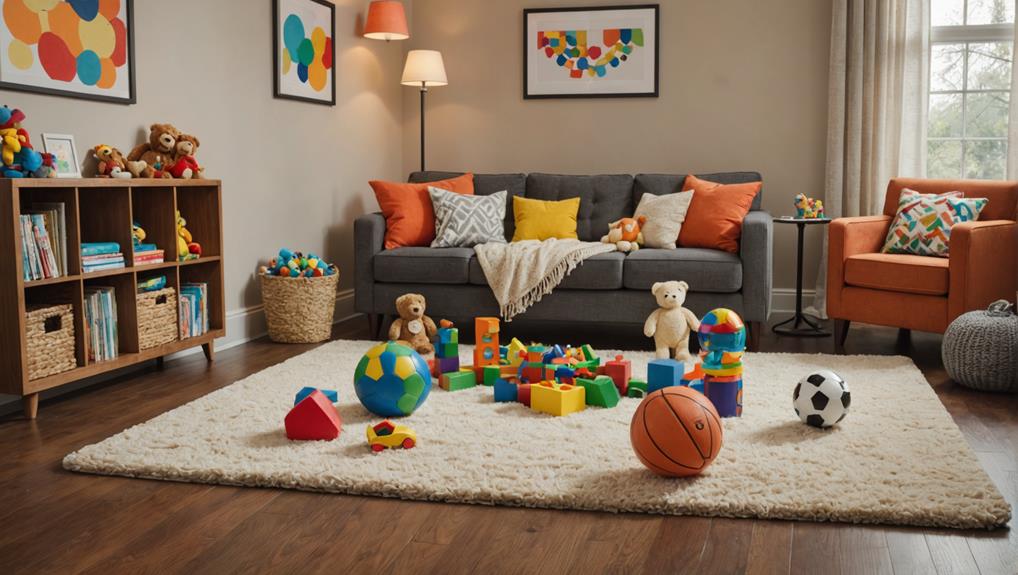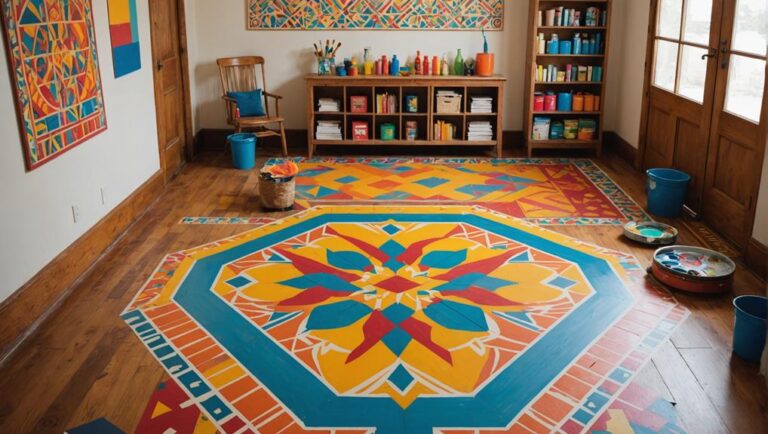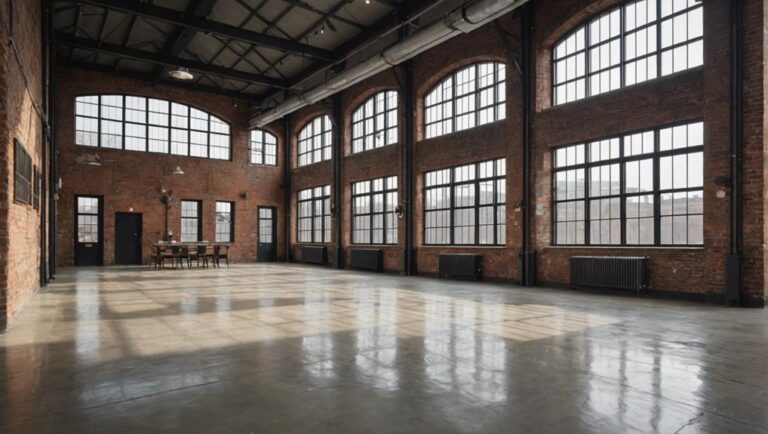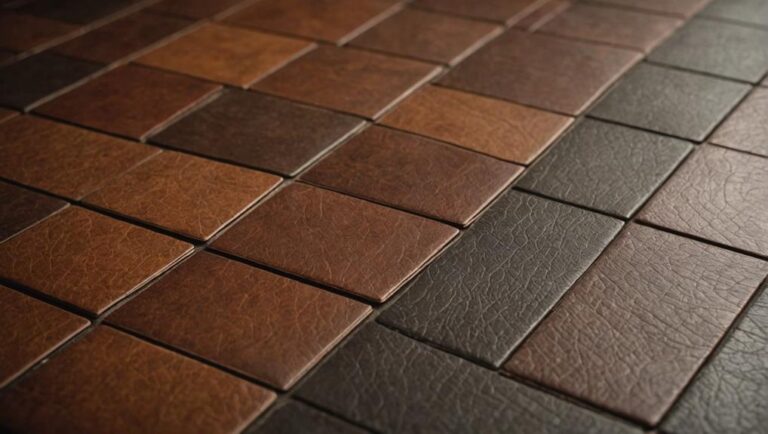To child-proof your hardwood floors, start by evaluating the type of flooring you have. Use thick, plush area rugs in high-traffic spots to cushion falls and prevent spills. Apply non-slip treatments like mats or traction strips for extra grip. Choose furniture with rounded edges and arrange it to create clear pathways. Regularly clean spills immediately to avoid stains and damage. Cooking up a designated spill kit can be helpful too. Finally, consider installing safety gates to limit access to risky areas. With these tips, you can create a safer environment for your little ones, and there's plenty more to explore.
Assess Your Floor Type
When evaluating your floor type, start by identifying whether you have solid hardwood, engineered wood, or laminate flooring. Each type has unique characteristics that affect its durability and maintenance requirements, especially in a home with children.
Solid hardwood floors are made from a single piece of wood, offering excellent durability and the potential for refinishing over time. However, they can be susceptible to scratches and dents, which may require more frequent maintenance. To protect your hardwood, consider using furniture pads and avoiding shoes indoors.
Engineered wood, on the other hand, consists of multiple layers of wood veneer, providing enhanced stability and resistance to moisture. This type is often more durable than solid hardwood, making it a popular choice for families. Regular cleaning with a damp mop and appropriate cleaning products can keep your floors looking their best.
Laminate flooring is another option that mimics the appearance of wood while being highly durable and resistant to scratches and dents. It's generally easier to maintain because it withstands spills better than solid wood. Just be cautious with excess water, as it can damage the core layer.
Regardless of your floor type, always keep up with maintenance tips to guarantee longevity. Regular sweeping or vacuuming can prevent dirt and debris from scratching your floors. By understanding your specific flooring type, you can make informed decisions to enhance safety and maintain the beauty of your home for years to come.
Use Area Rugs Strategically
Using area rugs strategically can greatly enhance both safety and comfort in a home with children. By incorporating colorful patterns and soft textures, you can create a warm and inviting space while also minimizing the risk of slips and falls.
First, choose rugs that provide cushioning. Thick, plush rugs can soften the impact of falls, which is especially important for active toddlers and young children. Look for options made from materials that are easy to clean, as spills and messes are inevitable.
Next, consider the placement of your rugs. Position them in high-traffic areas where kids are likely to play, such as living rooms or playrooms. This not only helps protect the hardwood floors from scratches but also adds a layer of comfort for little ones who spend a lot of time on the ground.
In addition to safety, colorful patterns can stimulate your child's imagination and enhance the overall aesthetics of your home. Opt for designs that catch your child's eye, making the space more engaging and fun.
Lastly, guarantee the area rugs are appropriately sized for the spaces you're decorating. A rug that's too small can become a tripping hazard while one that's too large can overwhelm the room. By choosing the right size and style, you'll create a safe, comfortable environment that encourages your children to play and explore freely.
Apply Non-Slip Treatments
Even with area rugs in place, it's important to affirm that your hardwood floors remain safe for children. One effective way to enhance safety is by applying non-slip treatments. These treatments can help prevent slips and falls, giving you peace of mind while your little ones play. Here are three practical options to ponder:
- Non-Slip Mats: Place non-slip mats strategically in high-traffic areas. Look for mats with a rubber backing to ascertain they stay put. These mats offer extra grip and can absorb any falls, reducing the risk of injury.
- Traction Strips: Installing traction strips on slippery sections of your hardwood floors can greatly improve safety. These strips are easy to apply and provide additional grip, making it harder for your child to slip. They're especially useful in areas where your child might run or play, like hallways or near the kitchen.
- Anti-Slip Coatings: Think about applying an anti-slip coating to your hardwood floors. These coatings create a textured surface that increases traction without altering the beauty of your floors. It's a long-lasting solution that can withstand daily wear and tear.
Choose the Right Furniture
Choosing the right furniture can greatly enhance the safety of your hardwood floors for your little ones. When selecting furniture, consider materials that are durable and easy to clean. Softer materials, like upholstered furniture, can help minimize injury if your child happens to bump into them. Opt for items that have rounded edges rather than sharp corners, as these can pose a greater risk for accidents.
Furniture placement is also vital. Arrange your furniture in a way that creates open pathways for your child to move freely. Avoid overcrowding the room, which can lead to trips and falls. Be mindful of placing heavier pieces, like bookshelves or cabinets, against walls to prevent tipping, and secure them if necessary.
Additionally, use area rugs with non-slip backing to provide extra cushioning and stability in play areas. This not only protects your hardwood but also creates a safer surface for your child to play on.
Lastly, think about the height of your furniture. Low tables can serve as great play surfaces, but make sure they're not too low to become a tripping hazard. By choosing the right furniture materials and carefully considering furniture placement, you can create a safer environment for your little ones while protecting your hardwood floors. Remember, a thoughtful approach to your home's layout and furniture choices can greatly reduce the chances of accidents.
Regular Cleaning and Maintenance
To keep your hardwood floors looking great and safe for kids, establish a daily sweeping routine to remove dirt and debris. Don't forget to use spot cleaning techniques for any spills or stains that occur. Additionally, scheduling regular refinishing will help maintain the floor's durability and shine over time.
Daily Sweeping Routine
How often should you sweep your hardwood floors to keep them child-proof and clean? Establishing a daily sweeping routine is essential for maintaining a safe environment for your little ones. Regular sweeping helps remove dirt, dust, and debris that can create slippery surfaces or cause allergies. Here's how to implement an effective daily schedule:
- Choose the Right Sweeping Tools: Invest in a soft-bristle broom or a microfiber dust mop. These tools are gentle on your hardwood floors and effective at capturing dirt without scratching the surface.
- Set a Specific Time: Pick a time each day that works best for your family. Whether it's in the morning before kids wake up or after dinner, consistency is key to forming a habit.
- Involve the Kids: Make sweeping a fun activity. Encourage your children to help with light tasks, fostering a sense of responsibility while keeping them engaged.
Spot Cleaning Techniques
Spot cleaning your hardwood floors is vital for maintaining their appearance and safety, especially in a home with children. Accidents happen, and knowing how to handle them can make a big difference. For quick stain removal, act fast. Blot spills with a clean, dry cloth to absorb as much liquid as possible before it seeps into the wood. For tougher stains, mix a few drops of mild dish soap with warm water. Dampen a cloth with this solution and gently rub the affected area. Always verify the cloth isn't too wet, as excess water can damage the wood.
If you have pets, it's important to be proactive. Keep an eye on their activities, and clean up any accidents immediately. Use enzymatic cleaners specifically designed for pet stains, as they effectively break down odor-causing substances. After cleaning, always dry the area thoroughly to prevent moisture damage.
Regular attention to spot cleaning not only keeps your floors looking great but also contributes to a safer environment for your kids. By following these techniques, you'll maintain a clean, inviting space while minimizing risks associated with spills and stains.
Regular Refinishing Schedule
Regularly maintaining your hardwood floors is essential not just for aesthetics but also for longevity, especially in a busy household with children. Implementing a regular refinishing schedule can greatly enhance your floor's durability and safety. Here are some practical refinishing techniques to take into account:
- Assess Wear and Tear: Regularly inspect your floors for scratches, dullness, or discoloration. Identifying issues early can prevent further damage and guarantee a safer environment for your kids.
- Choose the Right Finish: Use durable finishes that can withstand wear from active children. Water-based polyurethane is a great option, as it dries quickly and is less toxic.
- Schedule Refinishing: Aim to refinish your hardwood floors every 3-5 years, depending on traffic and usage. This not only enhances aesthetics but also reinforces floor durability, making it safer for your little ones.
Protect Against Spills
To protect your hardwood floors from spills, consider using area rugs in high-traffic and play areas. These rugs can act as a barrier against messes and reduce the chance of damage. If a spill does occur, clean it up immediately to prevent stains and water damage.
Use Area Rugs
While spills are an inevitable part of life with young children, using area rugs can greatly mitigate damage to your hardwood floors. By strategically placing rugs in high-traffic areas, you can protect your floors from stains and scratches. Here are a few tips to reflect upon when selecting and placing your area rugs:
- Rug Placement: Position rugs in spots where your kids frequently eat, play, or engage in messy activities. This could include the dining area, playroom, or entryway.
- Rug Materials: Opt for rugs made from durable, stain-resistant materials like nylon or polypropylene. These are easier to clean and can withstand the wear and tear from active children.
- Non-Slip Backing: Choose rugs with a non-slip backing to prevent accidents. This adds an extra layer of safety, ensuring the rug stays in place while your little ones play.
Clean Spills Immediately
Spills are a part of life when you have kids, and how you handle them can make all the difference for your hardwood floors. Effective spill management requires a quick reaction to minimize damage. When a spill occurs—whether it's juice, milk, or food—grab a clean cloth or paper towel immediately. The sooner you act, the less likely the liquid will seep into the wood, causing stains or warping.
Start by blotting the spill instead of rubbing, as rubbing can push the substance deeper into the wood's finish. For sticky spills, a damp cloth can help lift the residue without scratching the surface. After you've blotted it up, be sure to dry the area thoroughly to prevent moisture buildup.
It's also a good idea to have a designated spill kit with essential supplies like cloths, a gentle cleaner, and a mop handy in areas where spills are likely to happen. Remember, your quick reaction is vital. By staying vigilant and prepared, you can protect your hardwood floors and keep your home safe for your little ones.
Install Safety Gates
Installing safety gates is a smart way to keep your little ones safe while protecting your hardwood floors from potential damage. With various baby gate options available today, you can find the perfect fit for your home. Safety gate installation can be straightforward, and it'll provide peace of mind as your children explore their environment.
Here are three essential tips to take into account when installing safety gates:
- Choose the Right Type: Look for baby gate options that suit your home's layout. Pressure-mounted gates are great for doorways, while hardware-mounted gates work well for top and bottom stairs. Make sure the gate is tall enough to deter climbing.
- Proper Height and Width: Verify the gate is tall enough (at least 30 inches) and fits snugly in the designated area. Measure the width of the opening before selecting a gate to avoid gaps that could pose safety risks.
- Secure Installation: Follow the manufacturer's instructions carefully during safety gate installation. Double-check that the gate is securely fastened and doesn't wobble. Regularly inspect the gate to make sure it remains in good condition and functions properly.
Educate Your Children
After setting up safety gates, it's important to educate your children about their surroundings and how to interact safely with your home. Start by teaching them basic safety awareness. Explain why certain areas are off-limits and why they shouldn't run or play rough near hardwood floors. Use simple language and relatable examples so they can easily understand the potential hazards.
Make safety a fun topic by incorporating games or role-playing scenarios. This not only helps them remember the rules but also makes learning enjoyable. When they demonstrate safe behaviors, use positive reinforcement. Praise them for following the rules or remind them how proud you are when they play responsibly. This encourages them to continue practicing safe habits.
Additionally, lead by example. Show them how to walk, not run, in the house and how to be careful when carrying toys or other items. Children often model adult behavior, so your actions will speak volumes. If they see you being cautious, they're more likely to mimic that behavior.
As they grow, continue to revisit the topic of safety awareness. Discuss new challenges they might face and how to handle them. Reinforce the idea that safety is a lifelong commitment, not just a one-time lesson. By consistently educating your children about safety in a supportive manner, you'll help them become more aware of their environment and reduce the risk of accidents on your hardwood floors.
Frequently Asked Questions
How Do I Repair Scratches on Hardwood Floors?
You'd think scratches on hardwood floors are the end of the world, but they're not! For scratch repair, start by cleaning the area, then apply a wood filler that matches your floor color. After it dries, sand it lightly for a smooth finish. Regular hardwood maintenance, like refinishing, can also help prevent future scratches. So, don't fret over those imperfections; just grab your repair kit and give your floors some love!
Are There Child-Safe Wood Finishes Available?
Yes, there are child-safe wood finishes available that prioritize safety without sacrificing quality. Look for eco-friendly finishes that use non-toxic ingredients, ensuring your home remains a safe environment for kids. Additionally, consider safe sealants that provide durability and protection without harmful chemicals. When choosing finishes, always check for certifications indicating they're free from volatile organic compounds (VOCs) to keep your space healthy and secure for your little ones.
What Age Should I Start Child-Proofing My Home?
You should start child-proofing your home as soon as your child begins to crawl or walk, typically around 6 to 12 months. At this stage, toddler mobility increases, making safety precautions vital. Secure furniture, cover sharp edges, and keep hazardous items out of reach. It's imperative to create a safe environment where your little one can explore without danger. Regularly reassess your child-proofing as they grow and their mobility changes.
Can I Use a Steam Cleaner on Hardwood Floors?
While steam cleaners can be effective for cleaning many surfaces, they're not always the best choice for hardwood floors. The moisture from steam can seep into the wood, leading to warping or damage over time. For hardwood floor maintenance, a damp mop with a gentle cleaner is often safer. If you're looking for cleanliness and safety, stick to methods that won't risk your beautiful floors' integrity. Always prioritize care over convenience!
How Often Should I Reapply Non-Slip Treatments?
You should reapply non-slip treatments based on the product's instructions, but generally, every 6 to 12 months is a good rule of thumb. Factors like foot traffic and cleaning methods can affect treatment frequency. Regularly check the effectiveness of your non-slip options; if you notice a decrease in grip, it's time to reapply. Keeping your hardwood floors safe is crucial, so don't overlook this important maintenance step!




